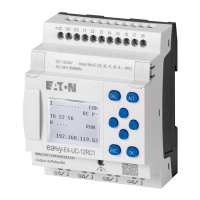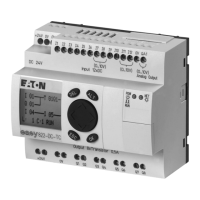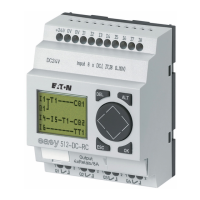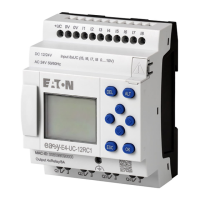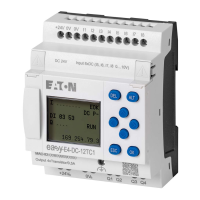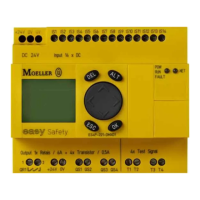6 Internal
6.1 circuit diagram cycle
188 Operating instructions 05/10 MN05013003Z-EN www.eaton.com
6.1.0.2 Evaluation in the circuit diagram and high-speed counter functions
When using high-speed counter functions, the signal state is continuously
counted or measured irrespective of the processing of the circuit diagram.
(C13, C14 high-speed up/down counters, C15, C16 frequency counters)
6.1.1 operation and effects on circuit diagram creation
easy evaluates the circuit diagram in these five segments in succession. You
should therefore remember two points when you create your circuit
diagrams:
• The changeover of a relay coil does not change the switching state of an
associated contact until the next cycle starts.
• Always wire forwards, upwards or downwards. Never wire backwards.
6.1.1.1 Example: switching in the next cycle
Start condition:
• I1, I2 switched on
• Q1 switched off.
This is the circuit diagram of a self-latching circuit. If I1 and I2 are closed, the
switching state of relay coil
ÄQ1 is latched via contact Q1.
• 1st cycle: Inputs I1 and I2 are switched on. Coil
ÄQ1 picks up.
• Contact Q1 remains switched off since easy evaluates from left to right.
• 2nd cycle: The self-latching function now becomes active. easy has
transferred the coil states to contact Q1 at the end of the first cycle.
6.1.1.2 Example: Do not wire backwards
The following example shows why you should not wire backwards.
In the third rung, easy finds a connection to the second rung in which the
first contact field is empty. The output relay is not switched.
When wiring more than three contacts in series, use one of the marker
relays.
I1-Q4-I3o
z-----k
hI2-I4-ÄQ2
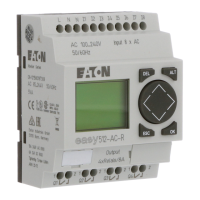
